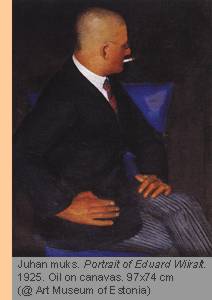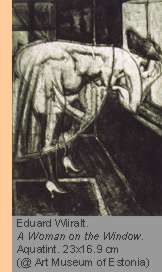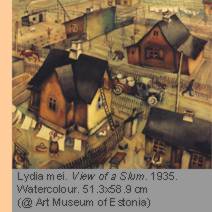

The Tartu milieu, irrespective of its diversity and picturesqueness, was
not nearly so remarkable as that of Dresden in 1922-1923 at the time when
Wiiralt lived there. Social contrasts, rife prostitution and the rhythm of
life of the metropolis, inspired him to produce works like In a Canteen (1922,
etching), In a Brothel (1922, aquatint), Hunger (1922, dry point), Late Stranger
(1923, dry point, copper engraving) and so on. Through these works Estonian
art was most directly and powerfully associated with verism. After returning
to Tartu, and in his early days in Paris, the veristic pathos in his work
diminished, giving way to a calmer, more descriptive neue-Sachlichkeit version,
a style that, from the mid-1920s onwards became synonymous with art déco.
This modification became the most widely disseminated version of neue Sachlichkeit,
involving, to a greater or lesser extent, almost every significant artist,
including members of the Estonian Group of Artists (founded in 1923) with
its cubist-constructivist orientation. Eduard Ole and Felix Randel, for instance,
experienced a relatively brief geometric period. Between 1926 and 1927 both
fully adopted the neue Sachlichkeit manner, nuances of which were already
present in their earlier works. With his paintings, watercolours and gouache
drawings, which so lightly and elegantly treat the topics of modern urban
life, Eduard Ole is an excellent representative of the aforementioned blending
of neue Sachlichkeit and art dòco. His manner resembles the Japanese
artist Tsougouharu Foujita who was quite popular in Paris at that time. Johannes
Greenberg's paintings of the early 1930s depicting emphatically wholesome,
sensuously languid female nudes seem, in their turn, to parallel the fashionable
types of Tamara Lempicka, the favourite painter of high society at that time.
Lydia Mei-Starkopf's masterful water colour still lifes and Arkadio Laigo's
still lifes and oil painting compositions include elements of both styles.
.
In Laigo's early work during the second half of the 1920s and early 1930s,
the naivistic trend in neue Sachlichkeit prevails. This had been intimated
even earlier in such paintings as Laigo's Farm (1923, EMA) and Juhan Muks's
Mother (1923, EMA). Moreover, the geometrising generalisation of form also
brings them closer to the aspirations of the Estonian Group of Artists. Such
a naivistic approach that infused Estonian art, combined with neue Sachlichkeit,
helped many a struggling artist to find him or herself. This was the case
with Larin Luts who, at her graduation from Pallas, produced such extraordinary
works as Island of Happiness (1928, EMA), Gardener (1928, TAM) and Killing
Innocent Children (1928, EMA).
Estonian art


